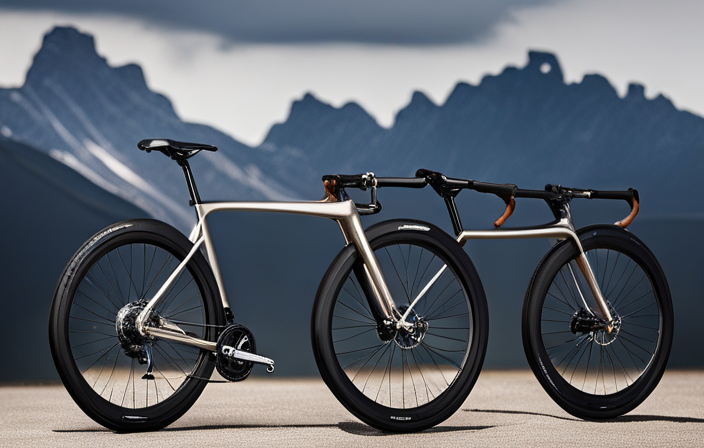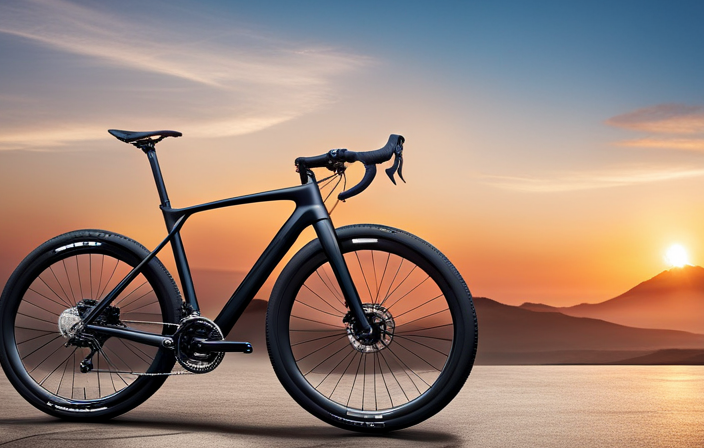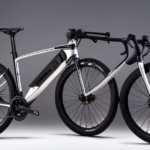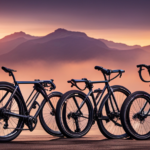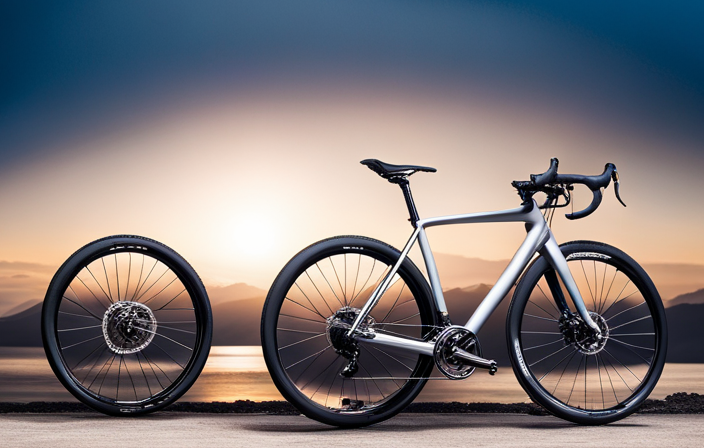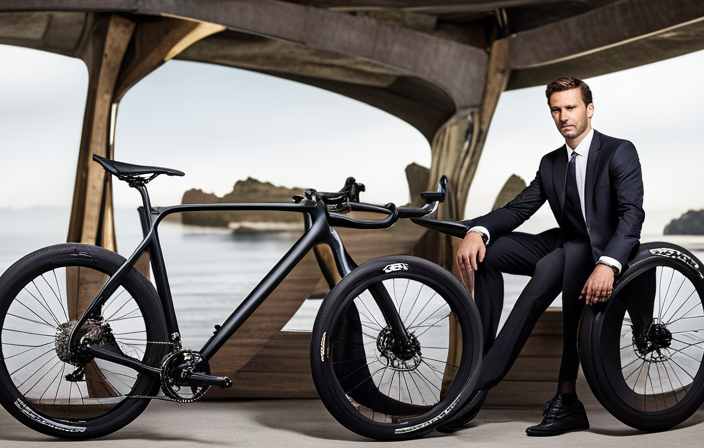Picture yourself riding a bicycle that brings together the durability of a mountain bike with the speed and effectiveness of a road bike.
Enter the gravel bike – an all-terrain machine built to conquer any surface it encounters. With its sturdy frame, wider tires, and unique geometry, this versatile two-wheeler offers unparalleled comfort and stability.
Equipped with disc brakes for reliable stopping power and clearance for larger tires, it’s ready to tackle both smooth roads and rough trails.
Join me as we explore what makes a gravel bike stand out from the crowd in this comprehensive guide.
Key Takeaways
- Gravel bikes have a sturdy frame made from materials like aluminum or carbon fiber, designed to withstand off-road challenges.
- They have wider tires for improved traction and stability on loose surfaces like gravel or dirt.
- Gravel bikes offer a comfortable riding position with handlebar options for stability and control, as well as innovations in saddle comfort.
- They have disc brakes for consistent and powerful braking performance, ensuring safety and control in challenging off-road conditions.
Sturdy Frame and Construction
A gravel bike looks like it’s got a sturdy frame and construction, so you won’t have to worry about rough terrains. The unique frame design of a gravel bike is specifically engineered to withstand the challenges of off-road riding. It is typically made from materials such as aluminum or carbon fiber, which provide strength and durability while keeping the overall weight of the bike relatively low.
The frame geometry of a gravel bike is also distinct, with a longer wheelbase and slacker head tube angle than traditional road bikes. This design allows for more stability and control when navigating through unpredictable terrain. Additionally, the frame often incorporates features like additional mounting points for racks and fenders, allowing riders to carry extra gear for long adventures.
When it comes to comfort, gravel bikes excel in providing a smooth and enjoyable riding experience. The sturdy frame absorbs vibrations from rough surfaces, reducing fatigue on long rides. Moreover, many gravel bikes feature technologies like suspension systems or flexible seat posts that further enhance comfort by dampening bumps and shocks.
Transitioning into the subsequent section about wider tires for increased stability: Speaking of stability on rough terrains, another key aspect of a gravel bike is its wider tires…
Wider Tires for Increased Stability
To increase stability, you’ll want to opt for wider tires on your gravel bike. Wider tires provide several benefits that make them ideal for off-road riding. Here are four key reasons why wider tires are a great choice:
-
Improved traction: Wider tires have a larger contact patch with the ground, allowing for better grip on loose surfaces like gravel or dirt. This increased traction enhances control and stability, especially when navigating through challenging terrain.
-
Enhanced stability: With their greater width, wider tires offer improved stability by providing a larger footprint on the ground. This helps to distribute the rider’s weight more evenly, reducing the chances of skidding or sliding on uneven surfaces.
-
Better shock absorption: The additional volume in wider tires allows them to run at lower pressures without sacrificing performance. Lower tire pressure absorbs vibrations and bumps more effectively, resulting in a smoother ride over rough terrain.
-
Increased confidence: The combination of improved traction, enhanced stability, and better shock absorption instills confidence in riders as they tackle various terrains with ease.
To fully enjoy these benefits, it’s important to ensure you maintain the recommended tire pressure for your specific wide tires. This will optimize performance and maximize comfort during your gravel adventures.
Transitioning into the next section about ‘unique geometry for comfortable riding position,’ it is crucial to consider not only tire specifications but also how the bike’s design contributes to an enjoyable experience off-road.
Unique Geometry for Comfortable Riding Position
When you’re riding off-road, it’s important to consider the unique geometry of your gravel bike for a comfortable riding position. Gravel bikes are designed with specific features that enhance comfort and control on rough terrains. One aspect of their unique geometry is the handlebar options available. Gravel bikes often come equipped with flared drop bars or wider flat handlebars, offering multiple hand positions for improved stability and control over varied terrain.
Another important factor in a gravel bike’s geometry is saddle comfort. Manufacturers have introduced various innovations to make long rides more enjoyable. Some gravel bikes feature shock-absorbing seatposts or flexible saddles that provide additional cushioning and reduce fatigue. These advancements in saddle technology allow riders to confidently tackle longer distances without sacrificing comfort.
Incorporating these unique handlebar options and saddle comfort innovations into the design of gravel bikes ensures that riders can maintain a comfortable riding position, even during extended off-road adventures. This thoughtful design enables riders to stay focused on the trail ahead, maximizing both enjoyment and performance.
Transitioning into the subsequent section about ‘disc brakes for reliable stopping power,’ it is essential to consider all aspects of a gravel bike’s design when aiming for optimal performance on unpredictable surfaces.
Disc Brakes for Reliable Stopping Power
The use of disc brakes on gravel bikes ensures reliable stopping power, enhancing safety and control on unpredictable terrain. Disc brakes are a crucial component of gravel bikes as they provide consistent and powerful braking performance in all weather conditions.
Here are three key aspects to consider when it comes to disc brakes on gravel bikes:
-
Disc brake maintenance: Unlike traditional rim brakes, disc brakes require less maintenance. The enclosed design keeps the braking system protected from dirt, water, and other elements that can affect its performance. Regular cleaning and occasional pad replacement are necessary to ensure optimal functionality.
-
Different brake pad options: Gravel bikes often come with different types of brake pads, such as organic or metallic compounds, each offering specific advantages. Organic pads generally provide better modulation and quieter operation, while metallic pads offer increased durability and heat resistance for prolonged rides.
-
Reliable stopping power: Disc brakes offer superior stopping power compared to rim brakes due to their larger rotor size and hydraulic or mechanical actuation systems. This allows riders to have precise control over their speed even in challenging off-road conditions.
With reliable stopping power provided by disc brakes, the next important feature of gravel bikes is clearance for larger tires and mudguards which I will discuss in the following section.
Clearance for Larger Tires and Mudguards
Another important aspect to consider is the clearance for larger tires and mudguards on gravel bikes. Gravel biking often involves riding on rough and unpredictable terrain, making it crucial to have a bike that can accommodate wider tires for enhanced stability and traction.
Larger tire options provide a greater contact patch with the ground, allowing riders to tackle uneven surfaces with confidence. This increased tire width also helps absorb shocks and vibrations, providing a smoother ride over gravel roads.
Furthermore, having clearance for mudguards is highly beneficial when riding in wet or muddy conditions. Mudguards help prevent dirt, water, and debris from splashing onto the rider’s body and bike components. This not only keeps the rider cleaner but also helps protect sensitive parts of the bike from potential damage caused by grit or excessive moisture.
Incorporating larger tire options and mudguards into gravel bike design demonstrates a thoughtful approach towards creating a versatile and adaptable cycling experience. With these features, riders can confidently venture into various terrains without worrying about losing control or experiencing discomfort due to adverse weather conditions or challenging surfaces.
Transitioning into the subsequent section about versatile gearing options for various terrains, it is essential to discuss how gear ratios play a vital role in optimizing performance on different types of gravel paths.
Versatile Gearing Options for Various Terrains
As we discussed in the previous section, gravel bikes are designed to provide clearance for larger tires and mudguards. Now, let’s delve into another important aspect of these versatile machines: their gearing options.
Gravel bikes are equipped with a wide range of gears that allow riders to conquer various terrains with ease. From steep climbs to fast descents, these bikes offer a comprehensive set of ratios to suit every rider’s needs. With multiple chainrings and a wide range cassette, you can effortlessly switch between gears and maintain an optimal cadence, no matter the terrain.
The advantage of this versatile gearing system is that it allows you to tackle both off-road adventures and smooth tarmac roads without compromising comfort or efficiency. Whether you’re climbing up a rocky trail or cruising along a flat country road, gravel bikes ensure that you always have the right gear ratio at your disposal.
Furthermore, gravel bikes offer a comfortable riding position that strikes a balance between efficiency and long-lasting comfort. This enables riders to spend extended periods on the bike without experiencing excessive fatigue or discomfort.
Next, we will explore another key feature of gravel bikes: their mounting points for racks and panniers. But before we move on, let’s take a moment to appreciate the versatility and performance provided by the gearing options available on these remarkable machines.
Mounting Points for Racks and Panniers
Gravel bikes offer convenient mounting points for racks and panniers, making it easy to carry gear on long rides. These mounting options are strategically placed on the frame, fork, and seat stays to provide optimal weight distribution and stability. The ability to attach racks and panniers allows riders to carry essential items such as extra clothing, tools, food, and water without compromising their riding experience.
When it comes to choosing the right gravel bike for your needs, it’s important to consider the weight capacity of the mounting points. Different bikes have varying limits in terms of how much weight they can safely carry. It’s crucial to adhere to these weight restrictions to ensure that your gear is secure and doesn’t affect your bike’s performance or handling.
Some gravel bikes also come equipped with additional mounting points for accessories like bottle cages or fenders. These extra attachments further enhance the bike’s versatility by providing options for carrying more gear or adding protection from elements like mud or rain.
In conclusion, gravel bikes excel in providing practical solutions for carrying gear during long rides. With their well-placed mounting options and consideration for weight capacity, riders can confidently embark on adventures knowing that their essentials are securely stowed away.
Transitioning into the subsequent section about durable components for off-road riding…
Durable Components for Off-Road Riding
One key aspect to consider for off-road riding is the durability of the components. When tackling rough and challenging terrains, it’s crucial to have reliable equipment that can withstand the demands of gravel riding. Here are five essential durable components to enhance your off-road experience:
-
Durable Tires: Gravel bikes are equipped with wider tires that offer increased traction and stability on unpaved surfaces. Look for puncture-resistant options with reinforced sidewalls for added durability.
-
Lightweight Handlebars: Off-road riding requires maneuverability, and lightweight handlebars can make a significant difference in control and agility. Carbon fiber or aluminum alloy handlebars are popular choices due to their strength-to-weight ratio.
-
Sturdy Crankset: A robust crankset is necessary for transferring power efficiently from your legs to the bike’s drivetrain. Opt for durable materials like carbon fiber or high-quality aluminum that can withstand the rigors of off-road riding.
-
Strong Brakes: Reliable braking performance is crucial when navigating challenging terrain. Look for disc brakes, which provide excellent stopping power even in wet or muddy conditions.
-
Reinforced Frame: The frame serves as the backbone of any gravel bike, so it must be built to last. Look for frames made from high-quality materials such as carbon fiber or steel, with reinforced joints and additional protection against impacts.
Considering these durable components will ensure that your gravel bike can handle rough trails and demanding off-road adventures with ease. With these features in mind, let’s transition into discussing integrated suspension for added comfort without missing a beat.
Integrated Suspension for Added Comfort
To enhance your off-road riding experience, you’ll want to consider integrated suspension for added comfort while tackling rough terrains. Integrated suspension systems are becoming increasingly popular in gravel bikes due to their ability to absorb shocks and vibrations, providing a smoother ride on bumpy surfaces. These systems typically consist of a combination of suspension forks and seatposts that work together to dampen the impact of uneven terrain.
One example of an integrated suspension system is the Fox AX gravel fork. This fork features 40mm of travel and a lockout mechanism, allowing riders to switch between a more responsive suspension mode and a rigid mode for better efficiency on smoother surfaces. Another option is the Lauf Grit SL gravel fork, which utilizes leaf springs instead of traditional coil or air springs. This design provides a lightweight and maintenance-free solution for added comfort.
In addition to integrated suspension, versatile gearing is another important feature to consider for off-road riding. Gravel bikes often come equipped with wide-range drivetrains that offer enough gears to tackle both steep climbs and fast descents. This ensures that you can maintain an optimal cadence regardless of the terrain.
Transitioning into the subsequent section about gravel-specific handlebars for better control, it’s crucial to have a bike setup that allows you to feel confident in any riding situation.
Gravel-Specific Handlebars for Better Control
For improved handling and control on gravel terrain, it’s essential to consider using handlebars specifically designed for off-road riding. Gravel-specific handlebars are specially crafted to provide riders with better grip options and enhanced maneuverability, ensuring a more enjoyable and secure riding experience.
Here are four key features that make gravel specific handlebars stand out:
-
Flared Drops: Gravel handlebars often feature flared drops, which means that the bars widen as they extend away from the stem. This design provides riders with a wider hand position, offering increased stability while navigating rough terrains.
-
Ergonomic Shape: These handlebars come with an ergonomic shape that allows for multiple hand positions. With different areas to place your hands, you can easily adapt to changing conditions and find the most comfortable grip for maximum control.
-
Shock Absorption: Many gravel-specific handlebars are built with shock-absorbing materials or designs. This helps reduce vibrations and impact from uneven surfaces, minimizing fatigue in your hands and arms during long rides.
-
Integrated Cable Routing: To maintain an organized appearance and prevent interference when riding off-road, gravel-specific handlebars often feature integrated cable routing. This ensures smooth shifting and braking performance while keeping cables protected from dirt and debris.
Considering these features when choosing your gravel bike’s handlebars will greatly improve your overall control on challenging terrain.
Speaking of enhancements, let’s now explore how increased bottom bracket height contributes to improved clearance.
Increased Bottom Bracket Height for Clearance
When riding on challenging terrain, you’ll appreciate the increased bottom bracket height of your gravel bike for improved clearance. The bottom bracket is the part of the bike where the crankset and pedals are attached. It determines the distance between the ground and the lowest point of your bike’s frame. In a gravel bike, having an increased bottom bracket height is crucial for tackling uneven surfaces, obstacles, and rough trails.
Gravel bikes are designed with a higher bottom bracket compared to road or mountain bikes. This allows riders to navigate through rocks, roots, and other trail features without worrying about hitting their pedal or crankset on the ground. The added clearance provided by an elevated bottom bracket helps prevent damage to these essential components and improves overall stability on challenging terrains.
To give you a better understanding of how different bottom bracket heights can affect your gravel biking experience, here’s a comparison table:
| Bottom Bracket Height (mm) | Clearance (mm) | Terrain Suitability |
|---|---|---|
| 70 | 250 | Mild gravel roads |
| 75 | 275 | Technical trails |
| 80 | 300 | Extreme off-road |
As you can see from this table, an increased bottom bracket height translates to greater clearance and expands your options when it comes to choosing riding routes. With improved clearance provided by your gravel bike’s elevated bottom bracket, you’re ready to explore more demanding terrains.
Now let’s delve into another important aspect of gravel biking: tubeless tire setup for puncture resistance…
Tubeless Tire Setup for Puncture Resistance
When it comes to gravel bikes, increased bottom bracket height is crucial for providing ample clearance over rough terrain. This design feature allows the bike to navigate obstacles such as rocks, roots, and uneven surfaces without compromising stability or risking damage to the frame.
However, another important aspect of a gravel bike’s performance is its tire setup. One popular option for gravel bikes is a tubeless tire setup. Tubeless tires offer numerous benefits that enhance the overall riding experience.
Firstly, they provide superior puncture resistance compared to traditional clincher tires with inner tubes. This is because there is no tube to pinch and puncture when riding over sharp objects. Additionally, tubeless tires allow for lower tire pressures, which improves traction and comfort on rough surfaces.
To ensure optimal performance and longevity of tubeless tires, regular maintenance is necessary. This includes checking tire sealant levels, inspecting for any cuts or damage on the tire sidewalls, and periodically refreshing the sealant when needed.
In summary, opting for a tubeless tire setup on your gravel bike can greatly enhance its puncture resistance and overall ride quality. By maintaining proper tire pressure and regularly inspecting your tires for any issues or wear, you can ensure a smooth and trouble-free ride.
Moving on to the next subtopic about lightweight design for easy maneuverability…
Lightweight Design for Easy Maneuverability
Achieving easy maneuverability on a gravel bike can be accomplished through a lightweight design. A lightweight frame is crucial in reducing the overall weight of the bike, making it easier to handle and navigate various terrains. By using materials such as aluminum or carbon fiber, manufacturers are able to create frames that offer excellent strength-to-weight ratios. These lightweight frames allow for quicker acceleration and better responsiveness, resulting in enhanced handling capabilities.
The reduced weight of a gravel bike with a lightweight frame also makes it more agile when it comes to cornering. The bike feels nimble and effortless to steer, allowing riders to easily navigate through tight turns or obstacles on the trail. This responsive handling is especially important when riding off-road where quick reactions are necessary to maintain control.
In addition to the frame material, other components like wheels and handlebars also contribute to achieving a lightweight design. Lighter wheels reduce rotational mass, which improves acceleration and overall maneuverability. Similarly, using lighter handlebars enhances the bike’s responsiveness by reducing unnecessary weight at the front end.
Transitioning into the subsequent section about frame materials such as aluminum or carbon fiber, we can see how these choices play a significant role in creating a lightweight gravel bike with exceptional maneuverability.
Frame Materials, such as Aluminum or Carbon Fiber
To achieve a lightweight design for easy maneuverability, you can consider using frame materials such as aluminum or carbon fiber. Both aluminum and carbon fiber have their own advantages and disadvantages when it comes to building gravel bike frames.
Aluminum is a popular choice for gravel bike frames due to its affordability and durability. It offers excellent strength-to-weight ratio, making it a great option for riders who prioritize stiffness and responsiveness. Aluminum frames provide a lively ride feel with good power transfer, allowing riders to efficiently tackle rough terrains. However, compared to carbon fiber, aluminum is generally heavier and may not offer the same level of vibration damping.
On the other hand, carbon fiber frames are known for their exceptional strength-to-weight ratio. They are incredibly light yet still maintain high levels of stiffness and responsiveness. Carbon fiber frames also excel in dampening vibrations, resulting in a smoother ride quality that reduces fatigue on longer rides. However, carbon fiber frames tend to be more expensive than aluminum ones.
In summary, choosing between aluminum and carbon fiber frame materials depends on your priorities. If you value affordability and durability while still seeking good performance, an aluminum frame might be the better choice. On the other hand, if weight savings and superior vibration damping are your main concerns despite the higher cost, then a carbon fiber frame could be the way to go.
When it comes to gravel bikes’ overall aesthetics beyond frame materials alone, eye-catching paint and graphics play an important role in enhancing style without compromising functionality or performance.
Eye-Catching Paint and Graphics for Style
Eye-catching paint and graphics on a gravel bike can enhance its style without compromising functionality or performance. When it comes to choosing the perfect color scheme for your gravel bike, there are endless options available. Manufacturers understand that riders want their bikes to not only perform well but also stand out from the crowd.
Eye-catching paint is often used to draw attention to certain features of the bike, such as unique geometry or frame details. For example, a bright, vibrant color might highlight the aerodynamic tube shapes or sleek lines of the frame. This not only adds visual appeal but also showcases the thought and design that went into creating the bike.
Graphics play an important role in enhancing the overall aesthetic of a gravel bike. Intricate patterns, logos, or even custom designs can be applied to various parts of the frame, giving it a personalized touch. These graphics can be subtle and understated or bold and eye-catching, depending on personal preference.
In addition to style, eye-catching paint and graphics also serve practical purposes. They can improve visibility on the road by making you more noticeable to other riders and motorists. Reflective elements incorporated into the design can increase safety during low-light conditions.
Overall, eye-catching paint and graphics add personality and flair to a gravel bike while maintaining its functionality and performance capabilities. Whether you prefer a sleek and minimalist look or something more bold and vibrant, there is undoubtedly an option out there that will suit your taste.
Frequently Asked Questions
What are some common frame materials used in gravel bikes?
Some common frame materials used in gravel bikes include aluminum, carbon fiber, and steel.
Aluminum frames are lightweight and affordable, making them a popular choice for entry-level gravel bikes.
Carbon fiber frames offer excellent stiffness-to-weight ratio, providing optimal power transfer and shock absorption.
Steel frames offer durability and compliance, ideal for riders seeking a comfortable yet sturdy ride.
Additionally, gravel-specific handlebars such as drop bars or flared bars are commonly used to provide multiple hand positions for increased comfort and control on rough terrain.
Are gravel-specific handlebars necessary for better control?
Gravel bike handlebars play a crucial role in controlling the bike’s movements and providing comfort during off-road adventures. While gravel-specific handlebars aren’t necessary for better control, they offer distinct advantages.
The wider flared drop bars provide more stability on rough terrains, allowing for enhanced maneuverability. Additionally, the increased hand positions give riders more options for comfort during long rides.
So, while not essential, gravel-specific handlebars can greatly enhance control and overall riding experience.
Interesting statistic: Studies have shown that using wider flared drop bars can increase stability by up to 20% compared to traditional road bike handlebars.
How does the increased bottom bracket height benefit the rider?
The increased bottom bracket height on a gravel bike greatly benefits the rider in terms of maneuverability. By raising the bottom bracket, the bike’s center of gravity is elevated, allowing for better clearance over obstacles such as rocks and roots.
This results in improved stability and control while navigating rough terrain. The higher bottom bracket also reduces the risk of pedal strikes, enabling riders to maintain a smoother and more efficient pedaling motion.
What are the advantages of a tubeless tire setup for puncture resistance?
Tubeless tire setups offer several advantages for puncture resistance. Firstly, they eliminate the need for inner tubes, which are prone to pinch flats and punctures. This reduces the risk of flats during rides, especially on rough terrain like gravel roads.
Additionally, tubeless tires can be run at lower pressures, enhancing traction and comfort without sacrificing performance. The sealant used in tubeless setups also helps seal small punctures as they occur, further reducing the likelihood of flat tires.
How does the lightweight design of a gravel bike contribute to easy maneuverability?
The lightweight design of a gravel bike contributes to easy maneuverability in several ways.
Firstly, the lightweight frame enhances agility and handling, allowing for quick and precise movements on various terrains.
Additionally, the suspension fork plays a crucial role in impact absorption, smoothing out bumps and rough surfaces to provide a more comfortable ride while maintaining control.
These features combine to create a bike that is responsive and nimble, making it ideal for navigating challenging off-road conditions.
Conclusion
In conclusion, a gravel bike is a sturdy steed that boasts a plethora of features for optimal performance.
From its robust frame to the wider tires that provide stability on rough terrain, every detail is designed with precision.
The unique geometry ensures a comfortable riding position, while disc brakes deliver reliable stopping power.
With clearance for larger tires and mudguards, puncture resistance is maximized through the tubeless tire setup.
And let’s not forget the lightweight design and eye-catching paint that adds style to this exceptional machine.
So hop on your gravel bike and embark on an adventurous journey like never before!
